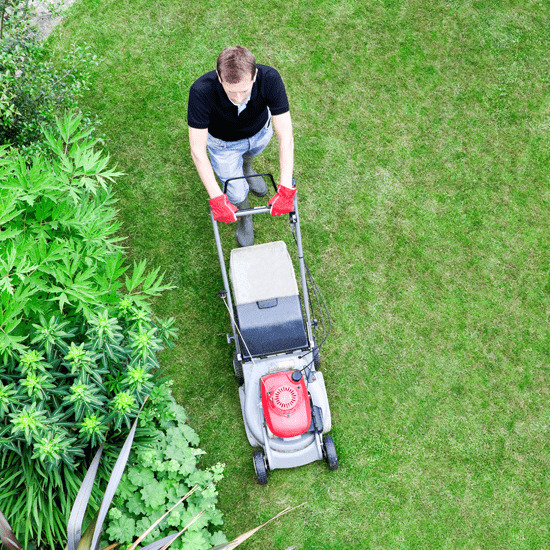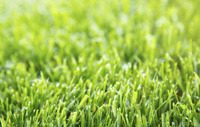Spring springs at the end of this month, which may come as a shock if you’re still donned in layers of sweaters or defrosting your car windows in the morning. But a brand new season really is on the way and sooner than you can say “April showers” lawnmowers, hedge trimmers and spades will return from their winter hibernation in your garage or shed.
Here are three important cleaning, fertilizing and mowing tips to get your spring lawn lush again:
- Even Leavin’: Half a year of rain, snow and wind has probably dried out your lawn and left it patchy and uneven. Start with a light raking to remove stray leaves as well as a heavier rake or dethatcher to untangle dense ground roots, which make it hard to resuscitate the soil. Then use a shovel to lower raised areas and fill in spots where the soil has eroded. This will make it easier to mow your lawn more evenly later.
- Reseeding: Before spreading seeds, find out which are most appropriate to your part of the country. Sunlight and temperature can also impact how successful your grass seeds grow so wait until a few warm spring days ideally above 65F before you start. Consider a soil test to help you determine which nutrients your garden is missing. Then water and fertilize your lawn at regular intervals. Ask your gardening expert if you’re not sure.
- Water: A healthy lawn needs about an inch of water a week. Rain is preferable so unless it hasn’t rained for three weeks or more, there’s no need for the sprinkler. When it is called for, 15-20 minutes for each area of your lawn is more than enough.
- Whoa on the mow: A tall, thick lawn makes it more difficult for weeds to establish themselves and also helps the soil retain moisture, so avoid mowing your grass too low or too often once a week will do. Also keep in mind that a low mow removes many of the nutrients stores in grass leaves, inhibiting their growth and making them less healthy.
Given up on your lawn? Here are some low maintenance alternatives to grass turf.
What are your proven dos and don’ts for keeping your lawn in shape? Share them now in the Shop Talk Blog community forum!
Did you know: 4 million plants in your garden
Each blade of grass is actually an individual plant. That means a typical lawn contains as many as 4 million grass plants. How about that? (Source)



Very interesting I will have to give this a try this spring.
Thanks for the tips, they will help me have a beautiful lawn.
What are these small tufts of very green with a white stripe in the center of each blade grasses? How do I get rid of them?
I used to have Chemlawn take care of my grass until their price tripled. I asked “how do you know when to fertilize the lawn?” Use the holidays, he said. 1.) Easter 2.) Memorial day 3.)4th of July 4.) Labor Day 5.) Halloween (brown lime). Done. A speader and 40lb. bags is all it takes…Savings,…about $420…
I started dethatching my lawn last week with a rake. I learned quickly that I need to buy a dethatcher attachment for my lawn mower because I have more than an acre to cover.
Last fall and last spring I planted about 200lbs of a mixture of grasses that are good in shaded areas as well as sunny areas. I am very pleased in the results as the fall planting stayed green throughout the winter. This may be due to a somewhat mild winter here in SC.
Did you know dandelion has a lot of medicinal properties… the substance the stem throws is good for cuts and burns. The flower cleanses the liver, kidneys and the leaves is also good for the digestive system…. who knew…
We have had moles off and on for years. The best thing we have found is to buy the stakes that you put in the ground and make noise. But the catch with that is they need to overlap. So if you have a big lawn, it could get a little pricey. You can buy them on Amazon and are called Sweeney’s Mole and Gopher Sonic Spikes. They come in packs of 2/$24.00 approx. You can also buy them at Ace Hardware, but they are 10.00 more a pack there. You need to have a supply of “D” sized batteries, as they each take 3 of them, but from my experience, they last almost the whole spring and summer (the batteries that is). They also have solar ones that are a bit more, but they work just as well (have some of them also). The trick with the spikes is to check on them periodically to make sure the batteries ARE working (you can hear the spikes working slightly, and they have a distinct sound) and don’t “drop” the battery load into the spike. Place it gently because the mechanism in the bottom is very touchy, and you could possibly damage it. Make sure you dig out the hole for the spike, DO NOT pound it in and keep the very top of it even with the ground so if you do have to change the batteries, all you have to do is unscrew the top and take out the battery load to replace then batteries.
I tried the worms, but its kind of hard to figure out sometimes where the throughway is, but they seem to help if you can figure out where the varmints are partying at most of the time <—–just a joke, the party thing, the moles…..NO joke at all! Good luck and I hope this helps. 🙂
Amazing how many people do not know the first thing about lawn care.
Reasonable instructions for a homeowner.
The water timings is a bit low if you haven’t had adequate rainfall for three weeks, dependent on location. As a former certified golf course superintendent the goal is to water deeply but infrequently if not natural rainfall is imminent.
Too many fertilize too early in the season due to the barrage of four step programs but that is another subject.
Utilizing preemergent crabgrass control products applied prior to crabgrass seed germination, soil temps. below 55 degrees F. and watered into the soil is one of the most important things to do for a good looking lawn all summer. We used a produce containing the active ingredient Prodiamine and had great success, like 98% control of crabgrass last summer.
Best of luck to all home gardeners this season!
Any advice on getting rid of moles?
Few comments on crabgrass. Best way IMHO is Scotts with Halts early in season. Follow directions. Mow highest setting on your mower. If you get crabgrass pull what you can but it spreads underground so that is minimally effective. Name brand sprays will work with multiple applications and then you will have dead spots.
Live in Tallahassse Florida and have a 85 lb dog 😉 want to use grass seed to start a lawn that has only al rye grass. Thinking about fencing off one area at a time to help reduce dog running around – how long before grass will be able to survive on its own – without the fence? He is also thinking that the rye grass and all will come back next year , just curious about that 😉
I a.m. so Happy too have this info as to which fertilizer goes I. The shin verses the shade. It helps. No to think that problem why son lawns are burnt up. And I Leander when to past many tulips their coming the on a new bed. Thank God!!!
I have st Augustine grass, so if I want to get rid of Bermuda I would mow my grass at the highest setting to choke out the Bermuda and the st Augustine will thicken up. Bermuda needs the sun so if the other grass is blocking it then it will die off. To get rid of crab grass you need to pull them out and make sure you get the roots and put them in the trash can. I fertilize with an organic fertilizer called sweet green found at ace hardware and not at Home Depot or lowes. If you don’t want to go organic a fertilizer called Nitrophos is great. Do not use weed feed because it kills the roots of trees. A product for getting rid of weeds is a Nitrophos pre and a post emergent weed killer.
This is motivating me to get out there. Snow go away!!!!!
I too, Learned a lot of NEW info from this article & was actually Surprized by a couple of things–Thanks
I have bluegrass , Bermuda grass and Crabgrass in my yard. How can I get Bermuda grass and Crabgrass out of my yard?
you don.t
I have different kinds of grass. Ky . Bluegrass. Bermuda grass. Crabgrass,
How do I get rid of Bermuda Grass and Crabgrass.?
I have different kinds of grass. Ky . Bluegrass. Bermuda grass. Crabgrass
Water lawn late nite not when hot !! Mow 4 times a month add lawn care and seed 2 times a year and wait for ,beautiful lawn.
Night watering promotes lawn diseases and fungus’ because it leaves standing water for too long.
Be careful of watering at night, disease will occur in certain areas. I usually water just before sun up.
Thank you for reminding me to rake. Things get matted in the crab grass and hickory nuts are the worst in areas of lite grass and exposed would. Taking will uplift the things that don’t need to stay
Learned a lot from this article